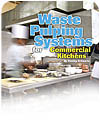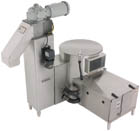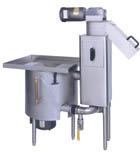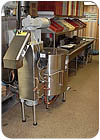
Issue: 6/06
What is a pulper? Sometimes referred to as a grinder, shredder or even "a disposer on steroids,"

The Waste Xpress pulping unit from Insinkerator.
Disposers vs. Pulpers
While a garbage disposer can only process food articles with limited amounts of paper, most pulper manufacturers have developed systems with the capability to process disposable serving and packaging materials as well. This tends to yield significant volume reduction due to the high amount of void spaces in such items. This has allowed school districts such as the Broward County School System in Fort Lauderdale, FL, to experience significant savings for over 30 years.
The WastePro pulping unit from Hobart.

A close-coupled unit from Champion Industries.
Benefits of Pulpers
Users of pulping systems experience the benefits of volume reduction and material handling, as well as freedom from the tedious task of sorting their waste for disposal. The volume reductions possible using a pulping system can be as high as 10 to 1, and the entire waste stream can be fed into the system except for metals, glass and cloth. Reductions in trash hauling and labor costs are quickly realized, with a return on investment that is often less than two years.
The Somat SPC-75 pulper is installed here as a close-coupled unit where pulping and extraction units are combined into one machine.